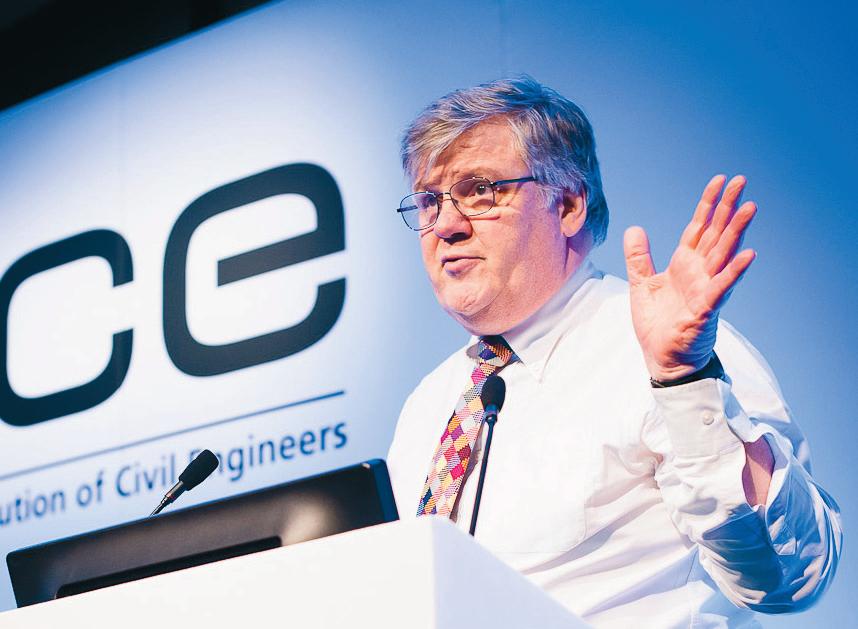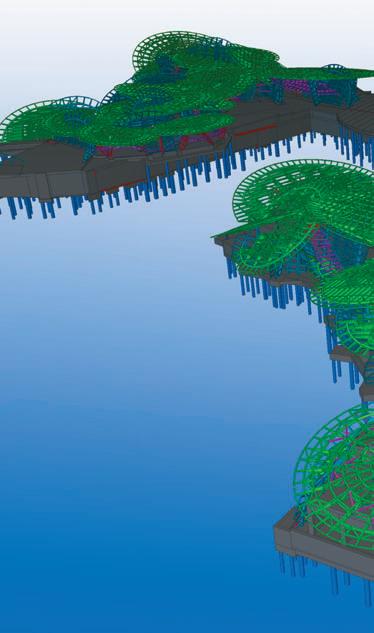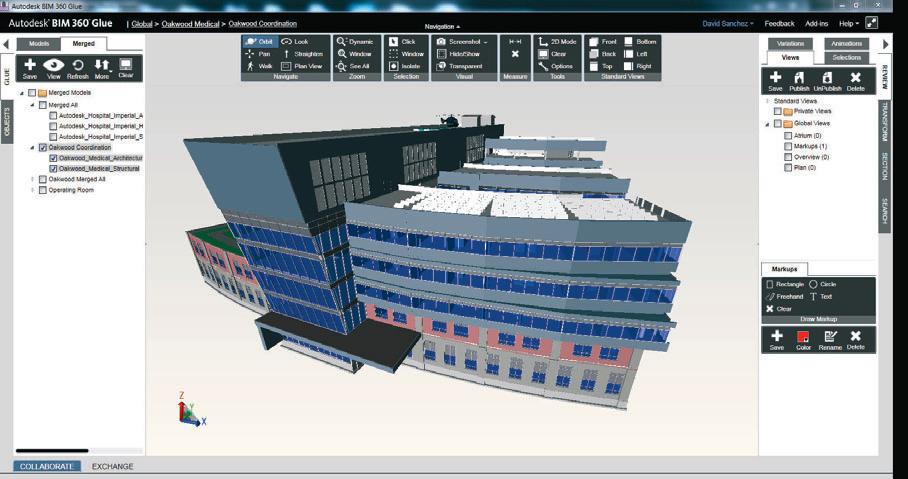
7 minute read
building analysis
Sefaira green building analysis
AEC magazine looks at a new web-based green building analysis tool that targets architects at the conceptual stage.
by Martyn Day
If you do not know how a building will perform, how do you know it is the best design? Costs Sefaira Concept Sefaira tual and massing stage of the design process. Unlike most analysis tools, the ‘engine’ is located in the cloud. The will be exponentially higher Price from £1,200 per year advantage being that massive if a design reaches the engi- ■ sefaira.com processing power can be used neers only to require addi- for very quick results for both tional mechanical compo- single and parallel runs. This nents for cooling, or changes made to natural makes Sefaira a SaaS (Software as a Service), ventilation systems. Architecture is just as accessible through a standard web browser. much engineering as it is art and architects As a service, users do not own the software need to avoid making early mistakes. but subscribe to annual usage for £1,200 a
So-called ‘Green Building’ applications seat, which includes training, support and are looking to fill this space. However, I feel updates. Larger firms pay £3,250 for a bunthe ‘green’ badge in this case seriously dle of three seats with enhanced training, undersells the capabilities of much of the enhanced support and access to engineers. software and may turn off designers to the For £100 a month or less, Sefaira provides a real value of these tools, which are able to lot of bang for your buck. improve the performance of the overall Sefaira has been designed to work with building design, not just its ‘green’ aspects. SketchUp as its base modelling source.
The problem with most building design While this free tool lowers the cost of entry tests is the time it takes. A single detailed and is ubiquitous in the market, most design test can take anywhere from one hour Building Information Modelling (BIM) manto several days for a qualified engineer to agers I know are trying to stamp out its use complete. This is because building design as it breaks the BIM workflow, with archican be incredibly complex. There are many tects lobbing in unco-ordinated changes via variables that can impact the end perfor- SketchUp model. That aside, SketchUp can mance and ongoing cost of maintenance: import models from all sorts of professional materials, orientation, glazing, airflow, ener- design tools so this is perhaps less of a deal gy usage, statutory compliance, usage, shad- breaker on the analysis side. ing, weather and solar gain. Sefaira has recently launched a plug in for SketchUp, which graphically shows how the Sefaira Sefaira analysis engine has broken down the Launched in 2009 and winner of last year’s model. Labelled textures (wall, glass, etc) Ecobuild ‘Green Building Innovation of the means users can assess if the correct allocaYear award’, Sefaira started its life as the tion has been applied. It is also possible to MBA research project of Mads Jensen (CEO) reallocate entities to help the software define and Peter Krebs (CTO). Now based in the make-up of a proposed design. London and New York the firm is building a However, it remains essential that all suite of cloud-based building analysis tools. items are correctly identified before analy-
The company’s first product is called sis, as it is ‘rubbish in, rubbish out’. The Sefaira Concept and is aimed at the concep- models do not have to be particularly detailed, for example it is possible to define floors based on the envelope in the system.
Start a Sefaira session by logging in to a browser. On log in, you are presented with a list of the projects you are currently working on and these can be shared with other project participants anywhere in the world. Collaboration on Sefaira is really a useful byproduct of using the cloud.
To start a conceptual or retrofit project the system needs a SketchUp model and a location. Using Google maps and a built-in sketch tool, a site can be easily drawn and brought in from SketchUp (should it have been created there or imported through it) to place the proposed building in its correct orientation. Surrounding buildings can also be quickly block modelled for over-shading analysis. Now the system automatically works out areas, volumes and gets the nearest weather data and even has the ability to run analysis with predicted climate change weather models.
It is possible to initially work with the default wall and glazing settings but all these can be edited by the user. All the spaces need to be allocated uses, which includes residential, office and capacity, together with lighting and load densities. The system can differentiate between week day and weekend loadings, supports zoning, cooling points and is highly configurable.
With a model, a site, weather and usage Sefaira is ready to run some numbers. The software performs an analysis for every hour of the year (by my calculations that is 8,760 hours). The company aims to return a completed set of results within 10 seconds, including a host of statistics such as the annual energy consumption, annual cost, annual CO2, heating and cooling loads as well as many other metrics. All are clearly
graphed and indicate the essential performance criteria. According to Sefaira these results, even quickly delivered, are within 5%-10% of competing systems at the conceptual design phase.
Now the fun starts. ‘Tick-box strategies’ can be applied to improve the performance by looking at materials, structure, orientation, U-values, brise soleil, Photos (PV), and solar shading and natural ventilation to name but a few. It is possible to create a number of parallel strategies for one design and compare the results. So, what if the roof was covered in PVs, or the design had higher U-values? These strategies could be analysed in parallel and compared side by side, showing performance results together with cost implications of build vs operation. Seeing the price impact could change a client’s mind for a better performing design.
It is also possible to combine a number of these strategies together to create ‘bundles’, which could be the basis of a new design or one of a number of designs that need to be compared and analysed. This is incredibly powerful and a great example of how the cloud will change the way we work — away from where any change in the design could lead to delays, to early on-demand analysis.
The system has the unique capability of producing response curves on a number of criteria that will help the user select the optimal setting vs cost. The response curves give a visual indicator of which factors will have the biggest impact on improving the design for the least cost, such as shading, glazing ratios and orientation.
Sefaira results can be used in the preparation of documents for LEED, Breeam, and Part L certification and has a built-in report and graph generator, ideal for presentations and design meetings. It is working on additional modules for financial planning, daylighting analysis, materials and others Conclusion While commendable, the ‘Green Building’ label has a distinct disconnect with what the majority of design jobs involve. LEED and Breeam are not applied to run of the mill projects and many clients will go for the cheapest building over the ‘green’ one.
However, these tools do have a place on every project because the industry has to better understand building performance. I would suggest that these ‘green’ tools are essential Performance Analysis tools and akin to Finite Element Analysis (FEA) and Computational Fluid Dymanics (CFD) tools that are used in engineering firms, especially high performance engineering such as Forumla 1 or aerospace, which simulate their prototypes before fabrication.
For a first generation application, Sefaira is incredibly impressive. The interface and
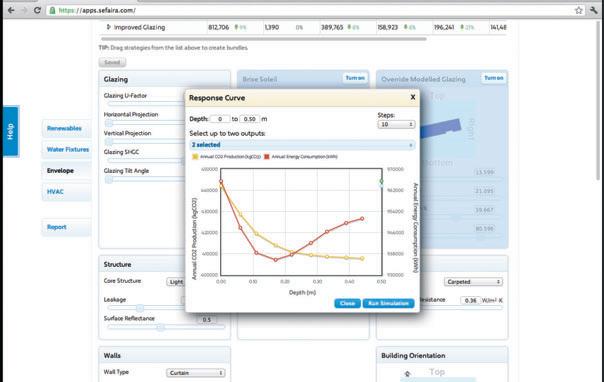
3
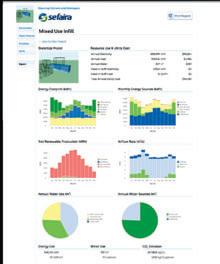
1 This is the primary interface for Sefairia users. It lists all the projects currently underway in which you are a participant. New projects are started here and all results are saved and kept ready for instant access 2 Unique to Sefaira, Response curves can be generated for a number of design criteria, assisting in selecting the optimum design for the cost. Here two glazing options are being compared 3 All analysis results on a model are clearly graphed and complete by the hour over a year. Essential feedback gained at the concept stage can be used to further refine the design to get the best possible savings
ease of use is very straightforward and working with SketchUp as a base modeller significantly lowers the cost and broadens the appeal of the service. With near instant results, it is possible to sit in front of a client and compare multiple design configurations and see the construction and operation cost implications. Or simply use the reports it generates to back up your final design submission.
Sefaira equips architects with a powerful range of tools and capabilities to understand a design with fewer changes as it goes through the engineering and documentation phases. Good building professionals analyse early and often.

